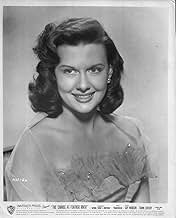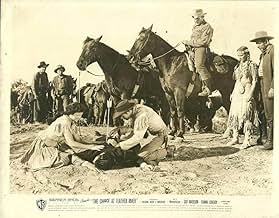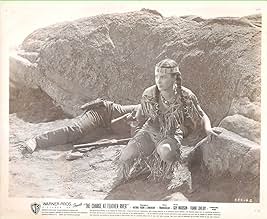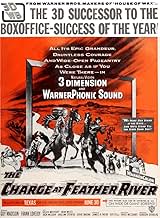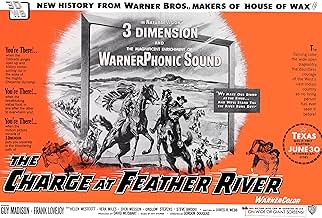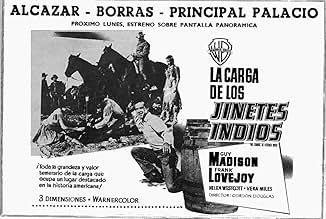IMDb RATING
6.2/10
762
YOUR RATING
In Colorado territory, Miles Archer is asked by the cavalry at Fort Bellows to aid in rescuing two white women abducted by the Cheyenne and to provide security for the railroad construction ... Read allIn Colorado territory, Miles Archer is asked by the cavalry at Fort Bellows to aid in rescuing two white women abducted by the Cheyenne and to provide security for the railroad construction teams.In Colorado territory, Miles Archer is asked by the cavalry at Fort Bellows to aid in rescuing two white women abducted by the Cheyenne and to provide security for the railroad construction teams.
- Director
- Writer
- All cast & crew
- Production, box office & more at IMDbPro
Featured review
Other commentators here have done an admirable job in addressing where "Charge at Feather River" fits in within the canon of Western movies, its similarity to "The Dirty Dozen" and other films of that genre, the use of 3-D effects, and even the origin of the Wilhelm scream. But what about the climactic, epic-making confrontation between Miles Archer (Guy Madison) and Chief Thunderhawk (Fred Carson)? In the action/adventure movies of the 1950s and 1960s, one knows the leaders will meet and fight it out. But when and where and how will it happen?
Thunderhawk has plenty of reasons to want to kill Archer himself. The whites are building a railroad through Cheyenne territory; their rescue effort has led to the death of Thunderhawk's bride-to-be. The cavalry troopers are occupying an island in the middle of the Feather River itself.
In the first charge, the Cheyenne have been repulsed. Their bodies float about the river. Stray horses amble about without direction. But the calm following this is deceptive. The Cheyenne prepare for another charge and this time Thunderhawk will personally take command.
At first, all goes well and a couple of the Guardhouse Brigade are picked off. Then, Thunderhawk commits his fatal mistake. At the head of about thirty to fifty braves, he veers off with only a half a dozen or so warriors to approach the island from the rear while the main bunch of Indians continues to hurl spears and to get shot, falling off their horses, and then bobbing in the river.
Thunderhawk, recognizable in his eagle feather headdress, leads his handpicked braves slowly up an embankment, on their bellies, in preparation for this "stealth" attack. But when they reach the crest of the embankment, above the river's edge, all goes wrong. They are seen too soon and all but Thunderhawk get shot down. Meanwhile, the main war party is beginning to back off.
Thunderhawk, without rifle or spear, cut off from all his men, draws his knife, preparing to do battle with Archer, one against one. Thunderhawk's very life now depends upon his skill with a knife. The bare-chested Cheyenne war chief, confident, powerful, motivated, eager for revenge and victory, squares off against Archer.
After only a few moments, Archer has maneuvered the chief to a slight earthen rise above the embankment, so that the daring, risk-taking, bold Cheyenne war chief stands a little bit above the cavalry officer. Archer goes for Thunderhawk's proud, taut, copper-bronze, native leader belly. As the knife goes in (off camera), Thunderhawk grunts in disbelief and topples, about to fall over the embankment. In a very clever shot, Guy Madison is seen looking over the embankment as Thunderhawk might have seen the view, his last before his death. Thunderhawk gives out a scream of terror as he tumbles down the embankment, splashing into the river. His horse makes way, only slightly, as the chief disappears under the water.
A valiant, determined, daring, native chief has lost his gamble.
Thunderhawk has plenty of reasons to want to kill Archer himself. The whites are building a railroad through Cheyenne territory; their rescue effort has led to the death of Thunderhawk's bride-to-be. The cavalry troopers are occupying an island in the middle of the Feather River itself.
In the first charge, the Cheyenne have been repulsed. Their bodies float about the river. Stray horses amble about without direction. But the calm following this is deceptive. The Cheyenne prepare for another charge and this time Thunderhawk will personally take command.
At first, all goes well and a couple of the Guardhouse Brigade are picked off. Then, Thunderhawk commits his fatal mistake. At the head of about thirty to fifty braves, he veers off with only a half a dozen or so warriors to approach the island from the rear while the main bunch of Indians continues to hurl spears and to get shot, falling off their horses, and then bobbing in the river.
Thunderhawk, recognizable in his eagle feather headdress, leads his handpicked braves slowly up an embankment, on their bellies, in preparation for this "stealth" attack. But when they reach the crest of the embankment, above the river's edge, all goes wrong. They are seen too soon and all but Thunderhawk get shot down. Meanwhile, the main war party is beginning to back off.
Thunderhawk, without rifle or spear, cut off from all his men, draws his knife, preparing to do battle with Archer, one against one. Thunderhawk's very life now depends upon his skill with a knife. The bare-chested Cheyenne war chief, confident, powerful, motivated, eager for revenge and victory, squares off against Archer.
After only a few moments, Archer has maneuvered the chief to a slight earthen rise above the embankment, so that the daring, risk-taking, bold Cheyenne war chief stands a little bit above the cavalry officer. Archer goes for Thunderhawk's proud, taut, copper-bronze, native leader belly. As the knife goes in (off camera), Thunderhawk grunts in disbelief and topples, about to fall over the embankment. In a very clever shot, Guy Madison is seen looking over the embankment as Thunderhawk might have seen the view, his last before his death. Thunderhawk gives out a scream of terror as he tumbles down the embankment, splashing into the river. His horse makes way, only slightly, as the chief disappears under the water.
A valiant, determined, daring, native chief has lost his gamble.
Storyline
Did you know
- TriviaWILHELM SCREAM: A scream used for the character Private Wilhelm (recorded originally for Les aventures du capitaine Wyatt (1951)), can be heard when he is shot in the leg by and arrow and painfully lets out a Wilhelm. This famous sound effect has since been re-used in many films, including the Star Wars, The Lord of The Rings and Indiana Jones films.
- GoofsWhen Morgan sets Jennie free, she takes his revolver and then falls from the cliff, taking his revolver with her. In subsequent shots, however, Morgan has a pistol again.
- ConnectionsFeatured in Une étoile est née (1954)
- How long is The Charge at Feather River?Powered by Alexa
Details
- Release date
- Country of origin
- Language
- Also known as
- La carga de los jinetes indios
- Filming locations
- Production company
- See more company credits at IMDbPro
Box office
- Gross US & Canada
- $3,650,000
- Runtime1 hour 35 minutes
- Aspect ratio
- 1.37 : 1
Contribute to this page
Suggest an edit or add missing content

Top Gap
By what name was La Charge sur la rivière rouge (1953) officially released in India in English?
Answer

















